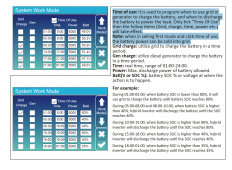GXMnow
Solar Wizard
- Joined
- Jul 17, 2020
- Messages
- 2,710
$3,000 is on the cheap side for an arm and a leg... But I get where you are going with this.
That is where the problem comes in. Any device that can "legally" push power back to the grid has to meet some strict standards. The cheap grid tie inverters rarely bother with all of the requirements. I am not even sure the Sol-Ark can do it. The OutBack SkyBox does, but it costs more than my Schneider. But the OutBack has much better software and a built in MPPT charge controller, but only a 5,000 watt inverter. The Sol-Ark is also quite expensive and has some excellent features and specs, but I could not tell from their online manual if it can grid sell from battery.
I came close to doing a "roll my own" setup with a combination of grid tie and off grid inverters and chargers and having a micro controller tie it all together, but in the end, I was not going to be saving much over the Schneider. The one thing that bugs me though, is the Schneider software has some rather dumb limitations. All of my solar is currently AC coupled on the output of the Schneider XW-Pro inverter. And with their current software, it is not able to trigger a battery charge cycle on it's own. If I start it charging, it fully charges, taking power from my existing grid tie solar inverters, and at 4pm, it switches to "Grid Support" mode and starts powering all of the loads in my backup panel, and pushing 900 watts (my setting) back to the main panel, up until 9 pm. It will then keep running my backup loads without exporting until the battery runs to my low cutoff set point. That all works great. But then the next morning, it won't start another charge cycle, it just sits at the low batter point. They expect you to also use a solar charge controller to do the charging.
Pushing power out to the grid is actually kind of tricky. From Solar, you have a limited current source, so the output current is also inherently limited. It keeps trying to pull as much power as it can from the solar panel, an then pushing it to the grid. It keeps adjusting the current, while monitoring the voltage from the solar panel. If it pulls too much current, the voltage falls, so it knows it past the maximum power point. When you connect a battery to the input of the same inverter, the MPPT search fails. As it increases the current it draws, the power just keeps climbing. If the MPPT is not well designed, it could actually pull enough power to burn out. This is why MPPT controllers have a maximum ISC input rating. That is the safe current limit. I watched a video where a guy was trying to feed a grid tie solar inverter from a battery, and it kept tripping the BMS current limit.
That is where the problem comes in. Any device that can "legally" push power back to the grid has to meet some strict standards. The cheap grid tie inverters rarely bother with all of the requirements. I am not even sure the Sol-Ark can do it. The OutBack SkyBox does, but it costs more than my Schneider. But the OutBack has much better software and a built in MPPT charge controller, but only a 5,000 watt inverter. The Sol-Ark is also quite expensive and has some excellent features and specs, but I could not tell from their online manual if it can grid sell from battery.
I came close to doing a "roll my own" setup with a combination of grid tie and off grid inverters and chargers and having a micro controller tie it all together, but in the end, I was not going to be saving much over the Schneider. The one thing that bugs me though, is the Schneider software has some rather dumb limitations. All of my solar is currently AC coupled on the output of the Schneider XW-Pro inverter. And with their current software, it is not able to trigger a battery charge cycle on it's own. If I start it charging, it fully charges, taking power from my existing grid tie solar inverters, and at 4pm, it switches to "Grid Support" mode and starts powering all of the loads in my backup panel, and pushing 900 watts (my setting) back to the main panel, up until 9 pm. It will then keep running my backup loads without exporting until the battery runs to my low cutoff set point. That all works great. But then the next morning, it won't start another charge cycle, it just sits at the low batter point. They expect you to also use a solar charge controller to do the charging.
Pushing power out to the grid is actually kind of tricky. From Solar, you have a limited current source, so the output current is also inherently limited. It keeps trying to pull as much power as it can from the solar panel, an then pushing it to the grid. It keeps adjusting the current, while monitoring the voltage from the solar panel. If it pulls too much current, the voltage falls, so it knows it past the maximum power point. When you connect a battery to the input of the same inverter, the MPPT search fails. As it increases the current it draws, the power just keeps climbing. If the MPPT is not well designed, it could actually pull enough power to burn out. This is why MPPT controllers have a maximum ISC input rating. That is the safe current limit. I watched a video where a guy was trying to feed a grid tie solar inverter from a battery, and it kept tripping the BMS current limit.



